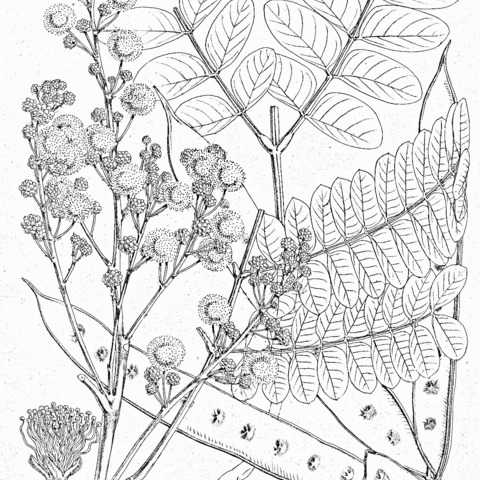Tree to 12 m high; bark smooth, yellowish to grey; young branchlets glabrous or subglabrous. Leaves glabrous or subglabrous to sparingly puberulous: petiole 5-8.5 cm long, with a large slightly raised elongated gland up to 11 mm long situated a short distance above the pulvinus; rhachis 3.5-13 cm long; pinnae 2-4 pairs; rhachillae 7-19(24) cm long; leaflets 5-11 pairs, 15-60 x 8-21 mm, obliquely oblong, elliptic-oblong or obovate, apex obtuse or rounded, often somewhat emarginate, upper surface very sparingly appressed-pubescent, lower surface paler, appressed-pubescent. Inflorescences globose, in axillary or terminal panicles; peduncles glabrous or sparingly puberulous. Flowers whitish, sessile or almost so; bracteoles rapidly deciduous. Calyx 2-3 mm long, glabrous or almost so. Corolla 4-6 mm long, apices of lobes with a conspicuous tuft of hairs. Stamens up to 1.5 cm long, united basally, tube not or scarcely exserted beyond the corolla. Ovary glabrous. Pods light to dark brown, 8-16 x 1.5-2 cm, linear-oblong, acuminate apically, glabrous or almost so, obscurely venose, slightly umbonate over the seeds, longitudinally dehiscent. Seeds 6-8 x 5-6.5 mm, flattened.
Tree 3–20 m high; bark thin, smooth, greenish. Leaves: axis commonly glabrous, with large gland near base and smaller ones between at least upper pairs of leaflets; pinnae (2–) 3–6-jugate; leaflets 6–9-jugate, ± inequilaterally oval or oblong, rounded-obtuse, often with an apiculum or emarginate, 1.5–6 cm long, 0.9–3.5 cm wide, ± appressed-puberulous or glabrous on both surfaces, drying much darker above. Inflorescence terminal or in axils of upper leaves, paniculate, glabrous; axis 8–24 cm long; peduncles 10–18 mm long, bearing clusters of 15–30 flowers. Flowers sessile, white to cream; calyx 1.5–2.5 mm long, ± appressed-puberulous or glabrous; corolla 4–5 mm long, appressed-puberulous at least on lobes. Pod linear to narrowly oblong, flat, 10–25 cm long, 12–30 mm wide, chartaceous, red-brown, glabrous. Seeds oval, compressed, 6.5–8.5 mm long, 4–6.5 mm wide, brown.
Trees, deciduous, to 15 m tall. Branchlets slightly pubescent or subglabrous. Leaf petiole with an oblong gland ca. 1 cm above base; pinnae 3-5 pairs, 15-20 cm; petiolules ca. 2 mm; leaflets 6-12 pairs, ovate to subrhombic, 3-4.5 × 1.2-2.2 cm, subleathery, sparsely appressed pubescent, main vein closer to lower side, base oblique, apex obtuse or emarginate. Heads ca. 20-flowered, arranged in axillary or terminal panicles. Flowers uniform, sessile. Calyx 2-3 mm, glabrous. Corolla yellow-white, ca. 6 mm; lobes lanceolate, ca. 2.5 mm, apex pubescent. Staminal tube longer than corolla tube. Ovary glabrous, subsessile. Legume ligulate, flat, 10-15 × 1.5-2.5 cm, glabrous. Seeds 8-12, obovoid-elliptic; pleurogram obovate-elliptic. Fl. May-Sep, fr. Sep-Feb of following year.
An erect medium sized tree. They are 10 to 25 m high. The twigs sometimes have hairs. The leaves are about 40 cm long and the pinnae are 6 to 10 in number and 15 to 20 cm long. The leaflets are 12 to 20 cm long. The flower is yellowish white in round heads at the ends of small branches. The pods are oblong, thin, smooth and flattened. They contain 8 to 10 seeds.


